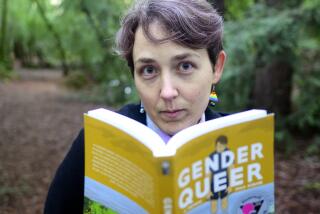More smoke than divine fire
- Share via
“THE Jesus Papers” is Michael Baigent’s revenge on “The Da Vinci Code.”
Even if he and one of his coauthors of “Holy Blood, Holy Grail” lose their British court case against “Da Vinci Code” author Dan Brown and Random House, Baigent still will be a winner. The attention generated by the trial -- on the charge that Brown’s novel borrows so heavily from their 24-year-old nonfiction book that damages should be paid -- and hype surrounding the forthcoming “The Da Vinci Code” movie is nothing short of heaven-sent for a book such as Baigent’s.
Without it, “The Jesus Papers” would probably go nowhere.
That’s because Baigent doesn’t deliver what he promises. The title and opening pages refer to a tantalizing document “containing incontrovertible evidence that Jesus was alive in the year A.D. 45.” Such a document, verified by carbon dating and subjected to the scrutiny of the world’s top archeological experts, would deliver a devastating blow to the core belief of Christianity: that Jesus rose from the dead.
This idea is dangled early then withdrawn, as Baigent explains that historical background is needed before considering such stunning news. This approach is similar to his earlier book, but what makes “Holy Blood, Holy Grail” so fascinating is an element of intrigue that builds from the first and never lets up -- a momentum “The Jesus Papers” lacks.
The new book centers on Baigent’s portrayal of Jesus in his time and milieu, stripped of mythology (birth by a virgin), of celibacy (Mary Magdalene, his mate) and the supernatural (that he didn’t rise from the dead but survived the crucifixion). His intention is to give us not “the Jesus of faith,” the divine figure artificially created centuries later by councils of bishops, but the Jesus of history, “a man who spoke of God, who expressed a divine message, but who did not himself claim to be God.”
Baigent describes the turmoil of life in Judea in the 1st century. Frustrated by Roman occupation, the Jewish people anxiously awaited a savior to deliver them. Jesus, the author claims, was the offspring of a marriage that combined the regal bloodline of David (Joseph’s ancestry) and the priestly bloodline of Aaron (Mary’s), and he was watched by Jewish authorities, as closely as a major league scout watches a AAA ballplayer.
But Jesus’ adult ministry was a disappointment, especially to the Zealots, who wanted strength and militancy, not Jesus’ gospel of love and compassion. The final decisive moment, Baigent says, happened when Jesus sided with the Romans on taxes by saying “give back to Caesar what is Caesar’s.” This turned Jesus’ supporters “apoplectic with rage” and paved the way for betrayal. Enter an unexpected player, Pontius Pilate. How could the Roman procurator, Baigent asks, condemn and “execute a Jew who was supporting Rome”? To avoid punishing someone so publicly loyal to Rome, Pilate allowed Jesus’ death to be faked.
Some of this should sound familiar; there is a large body of work by writers struggling to find non-supernatural explanations for the claims made in the gospels. Baigent is aware of it and clearly identifies his scholarly debts. He borrows from Hugh J. Schonfield’s “The Passover Plot” for the details of a mock crucifixion as well as from his own “Holy Blood, Holy Grail.” In fact, much of what one finds in “The Jesus Papers” he already presented there, though not in as much detail.
Also more detailed in this book is Baigent’s explanation of Egyptian mysticism and how it influenced Jesus. (He tells us that Jesus’ spirituality could only have been learned in Egypt.) Baigent describes his travels to various places -- the Dead Sea, the ancient ruins at the Bay of Naples, the Nile -- to study local practices of the period and how these illuminate the mysticism in the gospels.
Much light is also shed on Baigent. “The Jesus Papers” is a very personal book. He’s outraged by the early Catholic Church’s consolidation of power, its crushing of dissent, its exclusion of women from leadership; he laments that vibrant texts like the Gnostic gospels were buried in the desert to protect them. He includes photos of himself at excavation sites and crouching in tunnels as if to suggest that understanding the faraway past requires some kind of physical contact.
“I love to travel to sacred sites and to feel them, to seek to understand them,” he writes. “Are such places intrinsically sacred, or do we make them so? Perhaps both. Sacred sites demand participation from the visitor, an entering into a relationship with them, an experience. And there lies the difference between a pilgrim and a tourist.”
Pretty soon, the reader realizes that there probably won’t be any “Jesus documents” -- that this book is really a private credo, an intimate declaration of belief dressed up to be the religious bombshell of the millennium. But then the long-anticipated appearance of the documents comes (or does it?) near the end. Baigent meets with an unidentified antiquities dealer who shows him two pieces of parchment:
“Each was about eighteen inches long and nine inches high.... These were ... the letters from Jesus to the Sanhedrin. They existed. I was silent as I fully enjoyed the moment.”
Then he adds, “I wished above all that I might have a familiarity with ancient languages. . . . It’s like holding a treasure chest but not having the key to open it.”
Earlier in the book, Baigent described himself as a devoted student of ancient history for many years, but here he can’t even pick out Jesus’ name nor does he have the dealer, who is elusive and disappears from the story, show him what it says. It is deeply insulting.
Why this ploy? Baigent’s theory of Jesus’ life seems compelling enough on its own. Did Jesus go to Egypt? Who was Mary Magdalene? Would Pilate go to such trouble over one Jew’s life?
Experts will debate such details for a long time, but the disappointing thing about “The Jesus Papers” is that Baigent’s personal search for the figure of Jesus is obscured by the hype of the book’s packaging -- as if to say such personal quests don’t mean much anymore.
More to Read
Sign up for our Book Club newsletter
Get the latest news, events and more from the Los Angeles Times Book Club, and help us get L.A. reading and talking.
You may occasionally receive promotional content from the Los Angeles Times.





